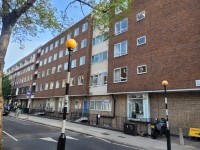Access Guide
Summary
- The following information describes the route from the Main Quad to Ramsey Hall via Gower Street, Grafton Way and Maple Street.
- The approximate distance of this route is 500m.
- The route takes approximately 6 minutes.
- The majority of paths along the route consist of tarmac or block paving with some slight gradients in places.
- The potential hazards on this route include; busy roads, crossing points (Gower Street, Tottenham Court Road, Whitfield Road) and congested pathways.
- For further information regarding Ramsay Hall please click here.
Main Quad
- The Main Quad is located off Gower Street.
- At the entrance/exit of the Main Quad there are two 85cm wide gates for pedestrians (photographs 7 and 8).
- These gates are located on either side of the 330cm wide main gate used by both vehicles and pedestrians (photograph 6).
- There are also bollards located immediately beyond/before the gates as you enter/exit the Main Quad (photograph 6).
- These bollards have gaps between 90cm-120cm wide.
- The Chadwick, North-West Wing, North Wing (Slade Building), Wilkins Buildings (including North and South Cloisters) and South Wing can be accessed via the Main Quad.
- Only the Chadwick, North-West Wing and Wilkins Buildings (except North Cloisters) are accessible via external ramps.
- Please see the relevant access guides for further information regarding access to these buildings.
- The majority of the Main Quad has a tarmac surface.
- The tarmac is loose/uneven in places.
- There are easy gradients throughout the Main Quad including on the pedestrian pathways.
- The pathways (photograph 9) consist mostly of block paving and are narrow and uneven in places.
- There is ample seating available in the form of wooden benches (photograph 10).
- These are located along the entirety of the pathways.
- There are 2 Blue Badge bays available within the quad (photographs 11 and 12).
- These are located on either side of the main building.
- There is an information point located at the front lodge, on the left hand side of the Main Quad entrance/exit gates (photograph 13).
- Please see the relevant access guide for further information regarding the front lodge information point.
Main Quad to Gower Street Crossing
- As you exit the Quad, turn right for 9m towards the Gower Street crossing.
- The surface here is a mixture of concrete, block paving and paving slabs.
- The surface is uneven in places.
- There is a lamp post on the left just before the crossing (photograph 4).
Gower Street Crossing
- The crossing has tactile paving and dropped kerbs on both sides of the road.
- There are moderate gradients between the path and the road on both sides.
- The road surface consists of tarmac and is even.
- The crossing is controlled by visual signals.
- The visual signals are activated via push buttons.
- The push buttons are 105cm above the ground.
- There are not rotating cones located at the base of the push button boxes to indicate when it is safe to cross.
- Caution is advised when crossing because of traffic.
- The traffic flow is from both directions.
- After crossing Gower Street the ramped entrance to Cruciform building is directly ahead.
- There is a slope with a slight incline at this entrance.
Gower Street Crossing to University Street
- Having crossed, turn left and continue back along Gower Place for approximately 50 metres towards the University Street turning.
- The path along this section of the route consists of tarmac.
- The path is mostly level and even with easy gradients in places.
- At the end of the path, turn right onto University Street.
- The path surface changes from tarmac to block paving upon entering University Street.
- There are lampposts and a phone box to the side of the pavement but they do not narrow the pavement to under 150cm.
University Street to Tottenham Court Road Crossing
- Having turned onto University Street, continue ahead for approximately 180 metres towards the Tottenham Court Road crossing.
- The path along this section of the route consists of block and brick paving.
- There is a slight easy gradient sloping towards the road along the entirety of the path.
- The path is uneven in places due to lowered/raised drain covers and paving slabs.
- After approximately 80 metres, cross the road at the Huntley Street crossing (photographs 3-5).
- The crossing has tactile paving and dropped kerbs on both sides.
- There are easy gradients between the path and the road on both sides.
- The road surface consists of tarmac and is level.
- The road is uneven in places.
- There are no visual signals available at this crossing.
- Traffic flow is from the left.
- Approximately 30 metres beyond the Huntley Street crossing, there is a vehicle entry road crossing.
- The crossing has no tactile paving on either side.
- The crossing has dropped kerbs on both sides.
- The road at the crossing consists of brick paving and has a slight easy gradient sloping downwards towards University Street.
- The road is mostly even.
- There are no visual signals available at this crossing.
- When crossing, be wary of vehicles entering/exiting.
- Approximately 40 metres beyond the vehicle entry road crossing, there is a second vehicle entry road crossing.
- This crossing is similar to the first except that it has a tarmac surface (photograph 10).
- Following the second vehicle entrance crossing, continue ahead for the remaining 25 metres until reaching the Tottenham Court Road crossing.
Tottenham Court Road Crossing
- The crossing has tactile paving and dropped kerbs on both sides so the pavement is level with the road.
- There are slight gradients between the path and the road on both sides.
- The road surface is cambered and consists of tarmac.
- The road is mostly even.
- There are visual signals available on both sides of the crossing.
- The visual signals are activated via push buttons. These are between the heights of 105cm and 112cm.
- There are rotating cones located at the base of the push button boxes to indicate when it is safe to cross.
- The traffic flow is from both sides, with road markings indicating pedestrians to look both ways.
Tottenham Court Road Crossing to Whitfield Street Crossing
- Having crossed over Tottenham Court Road, turn slightly left and continue ahead along Maple Street for approximately 70 metres towards the Whitfield Street crossing.
- The path at this section of the route consists mostly of block paving and concrete to one side.
- There is a slight easy gradient sloping towards the road along the entirety of the path.
- The path is uneven in places due to lowered/raised drain hole covers as well as broken paving slabs.
- The path narrows in places due to obstructions such as signs, bicycle racks and lampposts, however it never reduces the width under 150cm (photographs 1 and 2).
- This is a small section of brick paving and small posts to one side of the pavement before the Whitfield Street Crossing (photograph 5). Access along the pavement is not restricted to under 150cm wide.
- At the end of the path, cross over Whitfield Street at the crossing.
Whitfield Road Crossing
- The crossing has tactile paving and dropped kerbs on both sides.
- The path is level with the road on both sides.
- The road surface is cambered and consists of tarmac.
- The road is mostly even.
- There are no signals available at this crossing.
- Traffic flow is from the right hand side.
- Be wary of Cyclists entering the road from the left hand side.
Whitfield Road Crossing to Ramsay Hall
- Having crossed, continue ahead for approximately 50 metres towards Ramsay Hall.
- The path along this section of the route consists of block paving and trees planted to one side. The minimum width is approximately 135cm.
- There is a slight easy gradient sloping towards the road along the entirety of the path.
- The path is uneven in places.
- The path becomes narrow in places due to obstructions such as trees and railings.
- After approximately 40 metres, there is a vehicle entrance road crossing.
- The crossing has no tactile paving on either side.
- The crossing has dropped kerbs on both sides.
- There are easy gradients between the path and the road on both sides.
- The road consists of brick paving and is mostly level with a slight easy gradient sloping downward from right to left.
- The road is mostly even.
- The stairs to the main entrance to Ramsay Hall (photographs 6 and 7) are immediately to the right having crossed over the vehicle entry road.
- The step free entrance into Ramsay Hall (photographs 8 and 9) is located approximately 2 metres to the left of the main entrance stairs.
- For further information regarding access into Ramsay Hall please see the relevant access guide.


